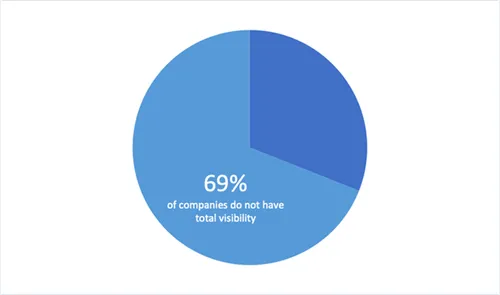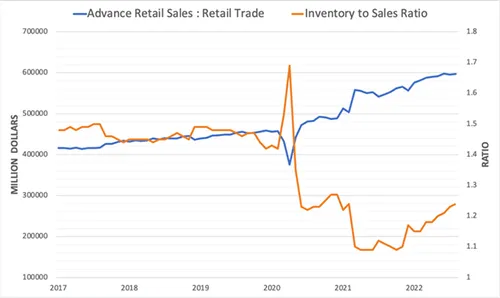This article that features PackageX was originally published on Microsoft Start.
In today's highly volatile economy, we see the consequences of inaccurate inventory management and demand forecasting in real-time. This is especially true in the retail sector, where supply chains are under immense pressure. Around 43% of small businesses in the U.S. do not track inventory or stock levels which increases the risk of stockouts and causes delays in order fulfillment. The current inflationary environment is putting unprecedented strain on businesses, and those who cannot accurately predict or manage their inventory are experiencing the effects most keenly.
Inventory management is a serious issue for any business, but it is especially critical for retailers who rely on just-in-time delivery to keep their shelves stocked. If retailers cannot accurately forecast demand, they risk overstocking or, worse, running out of inventory entirely. This can have a devastating effect on sales and profits, leading to giant markdowns. The average retail business in the U.S. has an inventory accuracy of just 65%, which is ridiculously low. As per Zippa, 69% of companies lack total visibility in their supply chain and inventory management, which explains the reason behind the high rate of inaccuracies.

Therefore, accurate forecasting and effective inventory management are critical for businesses to weather this storm. One of the best solutions to this problem is "Inventory Management Automation," which can work wonders for your businesses. Automated inventory management systems help retailers and wholesalers keep track of their inventory in real time. They streamline workflows, making the process faster and more efficient while saving valuable time. It can be a valuable source of empowering the logistics workforce instead of replacing them.
Inventory Management Crisis: An Overview
Some of the biggest U.S. retailers are getting hit by overstocking as they rushed to restock depleted inventories early in the pandemic. Stores like Target, Walmart, and Macy's are struggling with large stockpiles of apparel, workout equipment, and furniture because they shifted from a "just-in-time" to a "just-in-case" inventory management strategy. Sneaker giant- Nike reported that it did not have enough inventory to fulfill consumer demand for the last two years, but now it has a surplus of inventory. For this reason, it had to step up discounts to clear out the goods. Its inventories rose 44% to $9.7 billion, and the profit margin was squeezed due to high discounts.
If we talk about the inventory-to-sales ratio, it has remained at historically low levels for the retail sector, but the sales have escalated. According to the latest data shared by the U.S. Census Bureau, the inventory-to-sales ratio for U.S. retailers in August 2022 was 1.24, while retail sales reached $598,380.

The eCommerce giant Amazon also got into trouble due to a supply and demand mismatch. During the pandemic, Amazon doubled its warehouse capacity and is now struggling with overcapacity. Therefore, companies need to improve their inventory intelligence to prevent the losses caused by supply chain disruptions.
Automation in Inventory Management
Inventory management automation can solve a variety of problems, like managing the stock, forecasting demand, and planning for unforeseen events. In this way, businesses can operate smoothly and handle disruptions in the supply chain effectively. Nowadays, the inventory management software market is growing rapidly as businesses have realized how important automation is. The global inventory management software market is projected to reach $2.56 billion at a CAGR of 6.62% by 2029. This automated inventory software helps businesses automate their inventory operations, including manifest matching, item management in the warehouse, order fulfillment, and shipping.
Is Automation Technology Going to Replace Humans?
Advancements in robotics, machine learning, and artificial intelligence have marked a new age of automation, but technology can never replace human labor across industries. Humans have traits like cognitive thinking that can't be reproduced in robots and other technologies. Similarly, humans cannot replicate the accuracy, precision, consistency, and memory that technology offers. This indicates that humans and technology are meant to complement each other, not replace each other.

Businesses can only keep pace with today's economy by incorporating AI and machine learning into their workforce. This harmonious union is essential for the retail sector because they have to meet modern consumer demands, which is why retailers always look for technological solutions to increase efficiency and productivity.
Let's take the example of a warehouse with an average size of 185,000 square feet. Now imagine being a worker who has to match the inventory against the manifest, enter data manually, check inventory levels and identify inaccuracies constantly. It is a complex and tedious task for humans. Here inventory management technology can help humans monitor inventory levels, ingest data and generate data that guides management in decision-making.
How Does Inventory Management Automation Work?
Inventory automation works by collecting real-time data throughout the supply chain and transforming it into actionable insights using advanced software. It tracks products via methods like RFID tags, IoT sensors, or Bluetooth, depending on the level of accuracy and scale required. Networking technologies, such as Wi-Fi, 4G/5G, or private 5G, ensure seamless data flow to inventory management software. This software analyzes data, forecasts demand, and automates tasks like reordering stock and preparing for seasonal shifts. Integrated with systems like POS or order management, it provides real-time visibility across sales channels, enabling businesses to optimize inventory, minimize errors, and increase efficiency.
How Can Tech-Human Coexistence Improve Inventory Management?
While some businesses invest in inventory management automation, many still lag. According to Zippa, almost 67.4% of supply chain managers use Excel spreadsheets as an inventory management tool which consumes a lot of time and effort. Here inventory management software can significantly help because it helps the workforce do their job better and amplifies the human element.
Below are some advantages of inventory management automation that will convince you to invest in inventory management software and empower your workforce.
1. Automation saves you time and money
Manual labor costs a lot of money and time, especially in warehousing and inventory management. Counting products manually and maintaining spreadsheets is a laborious task for your staff. Also, these tasks have greater room for human error. Almost 65% of a typical U.S. warehouse's budget is consumed on manual labor, increasing by 3% yearly. ABI Research suggested that only by using RFID technology for inventory management can a business save thousands of dollars based on its inventory size.
This is where inventory management software helps. It removes manual processes from inventory management, reduces human error, saves time & money, and increases your staff's productivity and efficiency.
2. Automation helps in demand forecasting
Automated inventory management systems helps you keep track of stock changes, making trends more visible, and you can prepare for the next season. It enhances the accuracy in demand forecasting, due to which your inventory levels keep up with the demand even in peak seasons when the order volume is significantly high.
3. Automation prevents stock-outs & overselling
Stock-outs and overselling are two major challenges of eCommerce businesses that do not have an accurate handle on their inventory. You can manage your inventory across all sales channels with inventory management software that works as an automated stock control system. In this way, you know when the stock needs to be replenished.
4. Automation provides real-time access to data
An inventory management software helps your workforce know the location of every item, understand how well your warehouse is stocked and generate reports at any time. All these features provide you with a competitive advantage when it comes to managing inventory.
5. Automation increases scalability
Automated inventory management provides scalability to your business. You can adapt to market changes quickly and adjust your stock levels accordingly. Scalability is essential for businesses that depend on events like Black Friday.
6. Automation increases inventory visibility
Optimizing inventory visibility is one of the most critical improvements businesses need to make. In a supply chain network where order fulfillment occurs across multiple channels, inventory management software can reveal the complete availability of inventory across all channels, creating a better fulfillment experience. It helps synchronize inventory across different sales channels and locations, which improves visibility and allows businesses to maintain accurate buffer inventory levels.
Case in point: A third-party logistics company (3PL) that supports 5-6 different eCommerce brands and covers inventory storage, fulfillment, and returns management for them is a perfect example to explain how automated inventory management is going to uplift the workforce without snatching their jobs. Managing fulfillment for 5-6 retailers means storing a lot of inventory and managing thousands of SKUs. With manual systems, the staff has to match the inventory against the manifest, log them by hand, pick & pack the order manually and ship it to the customer. It takes a lot of time to process each order and increases the risk of error. Automated inventory management can streamline all these operations, and the human burden can be significantly reduced.
How to Choose the Right Inventory Management Software?
Enterprise-level businesses using spreadsheets and outdated manual systems for inventory tracking must invest in third-party inventory management software. However, not every software is built the same. Therefore, businesses should choose the inventory management software that suits their needs, varying from business to business.
Enlisted below is the criterion that inventory management software should meet:
- The software should easily connect with any enterprise resource planning software (ERP), customer relationship management software (CRM), or warehouse management system (WMS).
- It should work closely with your existing order management process.
- It should provide real-time updates on inventory positions and orders.
- The inventory management system should be able to add or remove warehouses quickly.
- It should provide real-time inventory visibility and support BOPIS, Curbside pickup, and Ship-from-store models.
- The inventory management software should offer the latest features, such as inventory receiving through a smartphone label scanner, bulk inventory import or export, asset tracking, managing storage, pick/pack, and shipping operations, creating digital manifests, and sharing inventory visibility with the customers.
{{returns-webinar}}
Ready to Empower Your Workforce?
In a world where technology is changing how we do business, it's important to remember that humans are still the most important part of any company. After all, it is human ingenuity and creativity that drives innovation. While inventory management automation can streamline processes and allow employees to focus on more creative tasks, it's important to remember that these systems are only as good as the people who design and operate them. With the right team in place, inventory management automation can empower humans instead of replacing them.
Inventory management automation, such as that provided by PackageX, is changing the game for retailers and warehouses. By leveraging the platform's flexible first-to-last yard logistics infrastructure, retailers can digitize their manual workflows, streamline their operations and unlock a host of new benefits. PackageX Inventory provides retailers a single source of truth for inventory and stock-level accuracy across the logistics ecosystem. It allows retailers to unify their inventory management, create digital manifests and automatically match incoming inventory to the ordered lists. In short, PackageX's API-firstheadless logistics cloud is a powerful tool that allows businesses to digitize and connect logistics across all industries.
Therefore, instead of fearing automation, businesses should embrace it as a tool to empower humans and improve their operations. By combining the strengths of human and machine intelligence, they can create a more efficient, sustainable, and human-centered supply chain ecosystem.
FAQs
What is automation in inventory management?
An automated inventory management system is a smart tool that helps businesses track their stock levels with minimal effort. Reducing the need for manual intervention ensures a proactive approach to avoiding common challenges like stockouts and excess inventory.
How do I create an automated inventory management system?
When choosing an automated inventory management software, it’s important to keep a few things in mind. Start by looking at your workflow—think about your products, where you need to track them, and the insights you want from automation. Also, make sure to consider the key features your business needs for a smoother process.
What is AI inventory management software?
AI improves traditional inventory management by using data analysis, machine learning, and predictive analytics. With these tools, AI can optimize key tasks like demand forecasting, supplier management, and stock replenishment, making the entire process smarter and more efficient.
Which technology can help you be more efficient while ordering inventory?
Businesses can streamline inventory tracking by using barcodes or RFID tags on their products. These tools make it easy to monitor stock levels, track product movements, and keep tabs on expiration dates. This approach not only enhances efficiency and accuracy but also improves traceability and accountability throughout the inventory management process.




